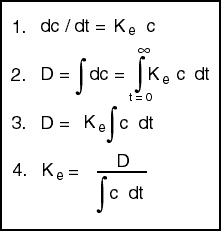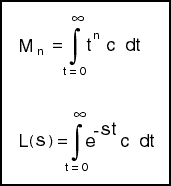A mammillary system of pools is pictured on the left. It consists of a central pool connected to a number of peripheral pools. This is usually a good model for a drug given IV. In the most simple version, the non-blood tissues are modeled as one pool, which means the drug level in the blood is represented by two exponential terms.
Two pools will not enable a good fit, if you have more than a few time points (e.g. greater than 10), the data is fairly accurate (e.g. standard deviation less than 10 percent), and the sample times cover a fairly long time (e.g. out to 24 hours). This is actually a vindication of the idea that the pools in the theory have a representation in the physical world. Some tissues, e.g. those in the liver, have an open architecture, allowing drugs to be taken up and returned rapidly to the circulation rapidly. Other tissues, e.g. those in skeletal muscle, have are perfused more slowly by blood that flows through vessels with walls of greater integrity, and thus give rise to longer time constants.
This is not a real problem, especially if you are using a computer to fit the data to exponentials. Just use three pools.


